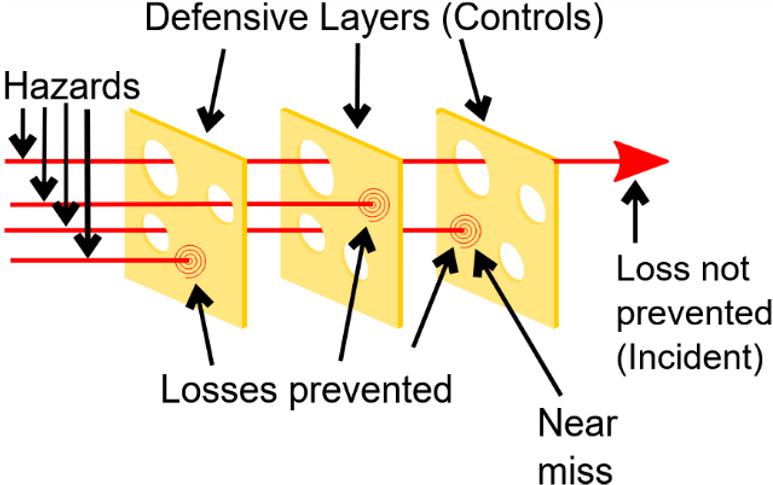The Language of Safety: Hazards – Seeing What Others Miss
“What hazard is visible in front of us here?”
I asked this question recently when out with a team preparing to commence a maintenance task in an industrial building.
“Slips and falls,” a team member offered almost immediately.
“That’s the consequence or unwanted event.” “What’s the hazard that could cause that outcome?”
Initial silence before another team member offered, “Wet surface from a safety shower leak.”
One question revealed a common issue when seeking to identify hazards and develop effective controls. Many people focus on the outcome or consequence rather than the underlying hazard.
The Invisible Language of Hazards
Hazards speak a quiet language most businesses struggle to translate.
According to ISO 31000:2018, a hazard is “an element which alone or in combination has the intrinsic potential to give rise to risk.” Put simply: it’s the danger before the unwanted event (consequence).
This seems straightforward until you review most hazard registers. What you’ll typically find aren’t hazards at all, but a list of:
- Unwanted events (Machine entanglement)
- Injuries (Broken bones)
- Generic categories (Electrical)
These aren’t hazards. They’re what happens when hazards are eliminated or controlled.
The Two Faces of Danger
Hazards can be both seen and unseen and it is important to consider and control them all.
Tangible Hazards are the physical conditions we can touch, see, or measure:
- Unguarded machine parts
- Hazardous chemicals
- Unstable structures
- Environmental conditions
- Poorly designed equipment
Last month I watched a maintenance team struggle with a valve assembly. The workspace was so cramped that proper posture was impossible. The hazard wasn’t “back strain” – it was poor equipment design creating unavoidable ergonomic stress. Simply recording “Use correct manual handling techniques” is not an efficient control in this scenario.
Intangible Hazards are the behavioural, procedural or systemic factors that create risk:
- Operator fatigue
- Untrained personnel assigned to complex tasks
- Production pressure overriding safety protocols
- Harassment creating distracted workers
- Data loss exposing sensitive information
During a mine site assessment, I noticed operators rushing through prestart checks. The hazard wasn’t “equipment failure”, it was a production pressures (or perceived production pressures) that inadvertently resulted in operators skipping safety steps.
The Critical Distinction
Understanding the difference between hazards, events and consequences isn’t academic, it’s essential for protection.
- Hazard: The condition creating potential danger (wet / slippery floor, unguarded machine).
- Event: What happens when someone interacts with the hazard (slip, entanglement).
- Consequence: The resulting harm (sprained ankle, amputation).
When businesses confuse these elements, it can result in the treatment of symptoms rather than causes.
I once reviewed an incident report that listed “falls from height” as the hazard. The actual hazard was unguarded or unprotected edges due to improperly built scaffolding with missing guardrails. This distinction matters because controlling unsecured scaffolding requires different actions than generally trying to prevent falls.
The Hidden Cost of Misidentified Hazards
When hazards are incorrectly identified, several critical failures follow.
- Ineffective Controls – You cant control what you haven’t properly identified.
- Recurring Incidents – The same events happen repeatedly because the root hazard remains unaddressed.
- Misdirected Resources – Time and money spent on controls that dont address the actual danger.
- False Sense of Security – Documentation looks complete while leaving workers exposed.
I previously provided support to a food processing plant that had implemented “slip prevention training” after multiple incidents. The actual hazard? Slipper floors from a drainage system that backed up during production peaks. No amount of operator training will fix a design flaw. And furthermore, this response essentially blames the operators for the issue, which can have the flow on effect of reducing morale. This in itself can become a hazard.
Becoming a Hazard Detective
To properly identify hazards, businesses must:
- Distinguish Between Cause and Effect – Train personnel to recognise the difference between hazards, events and consequences.
- Look Beyond the Obvious – Some of the most dangerous hazards are invisible, inaudible or otherwise hidden.
- Consider Combinations – Many serious incidents occur when multiple minor hazards combine. The Swiss Cheese Model.

- Involve Frontline Workers – Experienced workers often see hazards that others miss, just as those new to the job will see things with a fresh perspective.
- Use Structured Identification Methods – Task analysis, process mapping and scenario planning reveal hazards that casual observation may miss.
The Write Safe Difference
Getting hazard identification right is so crucial that we’ve built it directly into our assessment template.
We’ve included commonly understood and recognised hazards and consequences to guide users toward consistent hazard identification and risk analysis. Our methodology ensures you’re identifying what creates risk, not just cataloging what happens when risks materialise.
This approach doesn’t just improve documentation, it fundamentally enhances protection.
Safe Work Australia also has some very good reference material on hazards, which is worth a read.

How we write that’s different
Write Safe AU’s approach to hazard identification combines technical precision with practical reality.
Our team helps businesses develop a sharper eye for detecting hazards others miss. We translate the complex language of risk into clear, specific descriptions that point directly to effective controls. Through our structured templates and expert facilitation, we ensure your team identifies actual hazards, not just their effects.
This hazard-focused methodology means your documentation doesn’t just satisfy auditors, it genuinely protects your people by addressing dangers at their source. Because you can’t control what you can’t correctly identify.
Seeing the true hazard is the first step in preventing harm.
This is The Language of Safety. Clear documentation. Safer workforce.
Write Safe AU
